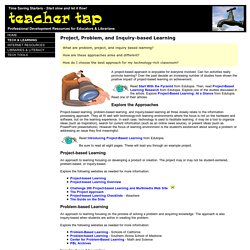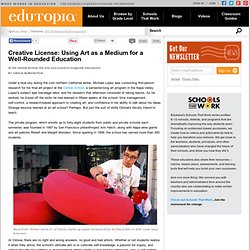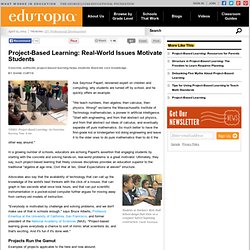

Project, Problem, and Inquiry-Based Learning. What are problem, project, and inquiry based learning?

How are these approaches alike and different? How do I choose the best approach for my technology-rich classroom? A project-based approach is enjoyable for everyone involved. Can fun activities really promote learning? Over the past decade an increasing number of studies have shown the positive impact of project-based learning on achievement. Read Start With the Pyramid from Edutopia. Explore the Approaches Project-based learning, problem-based learning, and inquiry-based learning all three closely relate to the information processing approach.
Read Introducing Project-Based Learning from Edutopia. Be sure to read all eight pages. Project-based Learning An approach to learning focusing on developing a product or creation. Problem-based Learning An approach to learning focusing on the process of solving a problem and acquiring knowledge. Explore the following websites as needed for more information: Inquiry-based Learning The "Best" Approach. Creative License: Using Art as a Medium for a Well-Rounded Educa. At the Oxbow School, the arts and research magically interweave.

Under a blue sky during the cool northern California winter, Michael Lopez was conducting first-person research for his final art project at the Oxbow School, a semester-long art program in the Napa Valley. Lopez's subject was low-wage labor, and his research that afternoon consisted of raking leaves. As he worked, he ticked off the skills he had learned in fifteen weeks at the school: time management, self-control, a research-based approach to creating art, and confidence in his ability to talk about his ideas. Strange lessons learned at an art school? Perhaps. The private program, which enrolls up to forty-eight students from public and private schools each semester, was founded in 1997 by San Francisco philanthropist Ann Hatch, along with Napa wine giants and art patrons Robert and Margrit Mondavi. Blood Work: Norbert Garcia Jr., of Tucson, touches up a giant red blood cell for his final project on AIDS. Start with the Pyramid: Real-World Issues Motivate Students.
Concrete, authentic project-based learning helps students illustrate core knowledge.

VIDEO: Project-Based Learning: An Overview Running Time: 9 min. Ask Seymour Papert, renowned expert on children and computing, why students are turned off by school, and he quickly offers an example: "We teach numbers, then algebra, then calculus, then physics. Wrong! " In a growing number of schools, educators are echoing Papert's assertion that engaging students by starting with the concrete and solving hands-on, real-world problems is a great motivator. Students at Harlem's Mott Hall School design their kites on a computer before beginning construction.
Credit: Edutopia Advocates also say that the availability of technology that can call up the knowledge of the world's best thinkers with the click of a mouse, that can graph in two seconds what once took hours, and that can put scientific instrumentation in a pocket-sized computer further argues for moving away from century-old models of instruction.